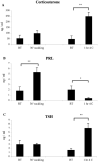Cocaine- and amphetamine-regulated transcript (CART) expression is differentially regulated in the hypothalamic paraventricular nucleus of lactating rats exposed to suckling or cold stimulation
- PMID: 17174283
- PMCID: PMC1963438
- DOI: 10.1016/j.brainres.2006.11.020
Cocaine- and amphetamine-regulated transcript (CART) expression is differentially regulated in the hypothalamic paraventricular nucleus of lactating rats exposed to suckling or cold stimulation
Abstract
Neural stimuli, such as suckling or cold exposure, increase TRH mRNA in the paraventricular nucleus (PVN) of the rat hypothalamus, yet only suckling induces prolactin secretion. As TRH co-localizes with cocaine- and amphetamine-regulated transcript (CART) in hypophysiotropic neurons of the PVN, and CART inhibits TRH-induced prolactin release but not TRH-induced TSH release in adenohypophyseal cell cultures, we raised the possibility that differential regulation of CART gene expression in the PVN may explain the differences in prolactin secretion following each of the two stimuli. Primiparous female rats were mated and handled daily during the pre- and postpartum periods. After delivery, the litter was adjusted to 8 pups and at mid-lactation, dams were separated from their pups for 8 h and exposed to either 1 h of cold or 30 min of suckling. Long-term effects of suckling were studied by separating pups from their mothers for 24 h, followed by a 12 h period of continuous suckling. Serum TSH levels increased in response to cold exposure, while prolactin levels were increased by suckling and diminished by cold exposure. CART mRNA levels increased in rostral and mid parts of the medial parvocellular PVN following cold exposure but not after suckling stimulation. These data demonstrate a differential regulation of CART gene expression in hypophysiotropic neurons in response to stimuli that increase TRH mRNA levels, and suggest that CART activation in the PVN may contribute to the decrease in PRL release when the thyroid axis is activated by cold exposure.
Figures




References
-
- Adels LE, Leon M, Wiener SG, Smith MS. Endocrine response to acute cold exposure by lactating and non-lactating Norway rats. Physiol. Behav. 1986;36:179–181. - PubMed
-
- Arancibia S, Tapia-Arancibia L, Assenmacher I, Astier H. Direct evidence of short-term cold-induced TRH release in the median eminence of unanesthetized rats. Neuroendocrinology. 1983;37:225–228. - PubMed
-
- Arancibia S, Rage F, Astier H, Tapia-Arancibia L. Neuroendocrine and autonomous mechanisms underlying thermoregulation in cold environment. Neuroendocrinology. 1996;64:257–267. - PubMed
-
- Broberger C. Hypothalamic cocaine- and amphetamine-regulated transcript (CART) neurons: histochemical relationship to thyrotropin-releasing hormone, melanin-concentrating hormone, orexin/hypocretin and neuropeptide Y. Brain Res. 1999;848:101–113. - PubMed
-
- Chomczynski P, Sacchi N. Single-step method of RNA isolation by acid guanidinium thiocyanate-phenol-chloroform extraction. Anal. Biochem. 1987;162:156–159. - PubMed
Publication types
MeSH terms
Substances
Grants and funding
LinkOut - more resources
Full Text Sources
Research Materials

